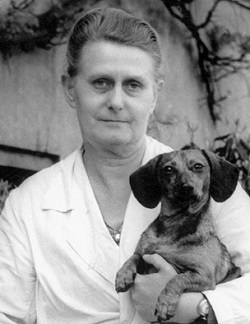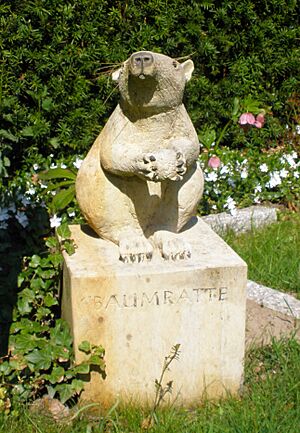Erna Mohr facts for kids
Quick facts for kids
Erna Mohr
|
|
|---|---|
 |
|
| Born | July 11, 1894 |
| Died | September 10, 1968 (aged 74) Hamburg, West Germany
|
| Nationality | German |
| Scientific career | |
| Fields | |
| Institutions | Zoological Museum Hamburg |
Erna W. Mohr (born July 11, 1894 – died September 10, 1968) was a German scientist who studied animals. She was a zoologist, which means she focused on fish and mammals. Erna Mohr worked for a long time at the Zoological Museum Hamburg. There, she led different departments, including those for fish and other vertebrates (animals with backbones). She was also a respected member of the Academy of Sciences Leopoldina and received a special honorary degree from the University of Munich.
Early Life and Museum Work
Erna Mohr was born in Hamburg, Germany. Her father was a school teacher. She lived most of her life in Hamburg, except for a short time in Schleswig-Holstein.
From 1914 to 1934, Erna taught high school. During this time, she also volunteered at the Zoological Museum Hamburg. She wrote many scientific articles, both for experts and for the general public.
Studying Fish
At the Zoological Museum, Erna Mohr started working with Ernst Ehrenbaum. They studied how to tell the age of fish. Erna was the first to use special fish scales, called ctenoid scales, to figure out a fish's age.
Later, she worked with Georg Duncker on classifying different fish species. This included studies on viviparous halfbeaks, sand lances, and shrimpfish. After Duncker retired in 1934, Erna Mohr became the head of the Fish Biology department. In 1936, she took charge of the Department of Higher Vertebrates. By 1946, she became the Curator of the entire Vertebrate Department.
Contributions to Mammal Studies
Erna Mohr also spent a lot of time studying mammals. She wrote about many different groups, like rodents, seals, and hoofed animals. In 1928, she joined the American Society of Mammalogists.
Przewalski's Horse and European Bison
In 1959, she wrote an important book about the endangered Przewalski's horse. This book was very special because it included firsthand stories about the early history of this rare horse.
Erna Mohr also kept detailed records, called studbooks, for the Przewalski's horse and the European bison. She was very involved in efforts to bring the European bison back into areas where they had disappeared.
Awards and Recognition
Throughout her career, Erna Mohr published over 400 scientific papers and books. In 1950, she received an honorary doctorate from the University of Munich. This is a special degree given to people who have made great contributions.
In 1966, she was made an Honorary Member of the American Society of Mammalogists. This is the highest award the Society gives. As of 1996, she was the only woman to have received this honor.
Erna Mohr passed away in Hamburg in 1968. She was buried in the Garden of Women at Ohlsdorf Cemetery. A statue of a hutia, which is a large rodent, marks her grave.
Legacy
Erna Mohr's work was so important that some new species were named after her. A type of fossil salamander, called Grippiella mohrae, and a bat mite, called Ichoronyssus mohrae, carry her name.
In 1984, on what would have been her 90th birthday, a street in Neuallermöhe, Hamburg, was named Erna Mohr Kehre. This means "Erna Mohr Turn."
She also wrote the mammal section for a German "Encyclopedia of the Animals." This encyclopedia was first published in 1971.


